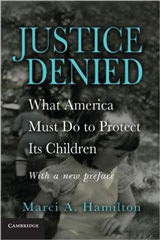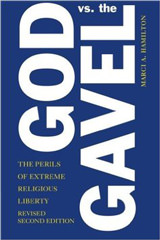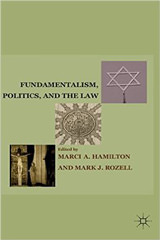The Religious Freedom Restoration Act (“RFRA”) has been an invitation to believers to think that there is a new America where they can live their faith in a self-referential universe and where they need not honor or even respect others’ beliefs. The Supreme Court’s Burwell v. Hobby Lobby decision came dangerously close to introducing a theocratically-ordered marketplace, as I discuss here and here. Tragically, RFRA has been draining the United States of its best qualities—a lively marketplace filled with diversity and an unwillingness to let religious identity trump friendship and cooperation.
Zubik: The Supreme Court Avoids the Worst of RFRA by Refusing to Interpret It
When the Supreme Court “decided” Zubik v. Burwell this week, by an unsigned per curiam decision, it avoided the worst of RFRA by refusing to interpret it. This was the case where nonprofits argued that it violated their faith to tell the government they needed an exemption from health care coverage of women’s contraception. If the Court had taken Hobby Lobby that one step farther by holding that the mere act of having to request an exemption could be a violation of RFRA, a certain category of believers would have received a message loud and clear that RFRA gives them the power to control others’ conduct while not having to tell the government they were avoiding a legal requirement. There is a phrase for that: religious anarchy, which since the framing of the First Amendment, has thankfully not defined the American space. (To be sure, it frequently defined colonial America with its isolationist, scattered theocracies but the First Amendment unraveled that era as Leonard Levy explained.)
In fact, I’m not a big fan of how Zubik was decided. After oral argument and in the wake of Justice Scalia’s death, which left the Court with a 4-4 split on the most divisive issues, the Court asked the parties to further explain what they would view as an appropriate accommodation/compromise. This was yet another awkward moment when RFRA re-cast the Supreme Court as lawmaker while it permitted RFRA to give believers a second bite of the legislative policy apple. The flipped roles of Court and Congress violate the separation of powers, but the Court to date has not had the courage to take back its power over interpreting the First Amendment and free exercise.
Instead, the Court folded in Zubik, essentially imploring the parties to find the compromise that would and could have been forged by members of Congress if RFRA hadn’t lured the nonprofits into the courts. And the parties, seeing a 4-4 split looming ahead, accommodated the Court by becoming, well, reasonable. The government said it could accept notice of the need for accommodation through means other than the form it had required, and the nonprofits said that their faith did not actually require them to deny contraception to employees so long as the system did not require them to authorize in some manner said contraception. Aha! A solution that brought the believers back from the brink of arguing that merely informing the government they needed an exemption violated their faith, as it potentially protected employees’ rights to seamless cost-free contraception coverage. So now the pending cases have been sent back down to their circuit courts to see whether there really is a workable compromise.
Justice Sotomayor’s concurrence emphasized that the per curiam opinion did not decide a single RFRA issue and that the paramount concern had to be that women receive “seamless” no-cost contraceptive coverage. Paul Clement at oral argument for the nonprofits had seemed to say that the answer to the case was to force women to sign up for two separate insurance plans—one from the nonprofit not including contraception and a separate plan for the contraception. Sotomayor sends a clear message that that is not the compromise she views as viable or acceptable. She is so correct. On the downside, however, is that Justice Sotomayor wrote only for herself and Justice Ginsburg. Where were Justices Breyer and Kagan? Or even Justice Kennedy? We’ll never know since the opinion was signed by Mr. Per Curiam.
The Do No Harm Act Is Introduced to “Fix” RFRA
With this soft shoe by the Supreme Court around RFRA and contraception this week, the question was left open whether RFRA will be a tool beyond the Hobby Lobby decision that lets employers shape their employees’ benefit plans to reflect personal religious belief. The Court’s backing off of a RFRA decision in Zubik seems to signal that the Hobby Lobby decision was as singular as Justice Alito said it was. In addition, on May 18, Reps. Joseph Kennedy III and Bobby Scott introduced the “Do No Harm Act.” This is the turn in religious liberty discourse and doctrine that the United States has needed since RFRA was first passed in 1993. This new bill deserves passage and will return significant quadrants of the religious liberty universe to one where being religious cannot justify harming another, whether a woman, child, LGBTQ individual, or employee. It is an antidote to some of the contemporary, corrosive religious triumphalism.
The Do No Harm Act would carve from RFRA the potential for believers to use it to harm others, either through discrimination or bad acts. And it exceeds the narrow focus on LGBTQ rights that has driven the movement against the state RFRAs; it protects not just LGBTQ individuals but also children. That alone tells us we have come a very long way since the RFRA of 1993 when it never occurred to anyone that it might be a haven for excusing discrimination, child sex abuse, trafficking, or neglect.
The list of supporting organizations, puts earth back on its proper axis. The “bi-partisan” Coalition for the Free Exercise of Religion behind the original RFRA was composed of an array of religious and civil rights groups, but everyone suppressed discussion of their real agendas. The Coalition was the oddest gathering, because they had an agreement that they would not discuss their individual agendas with lawmakers but only disclose their shared goal of high-level religious liberty rights. In effect, religious groups and civil rights groups voluntarily—for a time—abandoned their policy objectives to unite for the opaque RFRA right. Each side in the culture wars agreed to arm the other to their detriment. Lawmakers, the press, and the public frankly did not know that RFRA was motivated in large part to permit marital status discrimination in housing. Nor did they have a clue of the level of sex abuse in religious communities that religious leaders were actively concealing. In contrast, the supporters of DNHA share policy and moral agendas and are disclosing them as part of their support for DNHA. It’s called transparency.
In truth, the Supreme Court and the First Amendment need to be returned to their wise perch on religious liberty, and RFRA should be repealed outright. But the Do No Harm Act is as good a place to start as any to carve out of RFRA some of its worst incentives and inclinations. I have always had to hand it to those who selected RFRA’s name: that is a title that lawmakers found hard to vote against. Yet, the “Do No Harm Act” now rivals RFRA as a title that is hard to oppose. If you do, you support doing harm?! That’s funny, but it’s also sad that we need an amendment to any federal law to ensure that religious believers are adequately restrained from hurting others.
Sad or not, it’s reality, and the era for the Do No Harm Act is upon us.










as Adam responded I didnt even know that a mother able to make $8172 in one month on the internet . visit this site CLCK.RU/9v7Gt
asdgasdgsg
Two things — Sotomayor was joined by Justice Ginsburg. And, the per curiam likely was written by a man, but Kagan did join it w/o comment.
just as Tracy responded I am dazzled that someone able to make $4072 in 4 weeks on the computer . read this article CLCK.RU/9vNCb
dcvtvfcxvtg
as Virginia said I am startled that a stay at home mom can make $7871 in 1 month on the internet . try this site CLCK.RU/9vSPb
655555555555555555555555555555
Get 90 dollars /daily for working on the web from comfort of your own home for several h /day… Get paid regularly on a weekly basis… All you need is a computer, connection to the web, and a little free time… SELF40.COM
dsfsdfdsf
Earn 90 bucks every day for working over the internet from your own home for several hr’s every day… Get regularly paid once a week… Everything you need is a personal computer, connection to the web, and also some leisure time… TINY.PL/grj4d
zdrsvfcxdfrtr
I profit close to $6000-$8000 on monthly basis with my online job. Everyone willing to do simple at home work for several hours a day at your home and make decent payment for doing it… Try this work OW.LY/lKR8300yJWT
dfgweqwe
I think there’s some confusion here, because having the government control every facet of our existence is not somehow, “a lively marketplace filled with diversit,” it’s just a lot of power in the hands of ridiculous bureaucrats who are too stupid to create anything on their own. I find it equally interesting that in no way is the specific content of the “Do No Harm Act,” addressed, just vague references to the opinion of what it has.
Maybe, another option would be to have the government do as little as possible, particularly the Federal Government, since it obviously can’t do the things it clearly is supposed to do, maybe it could quit finding extra things for itself to do.
While Iran builds nuclear weapons we’re demanding women get free abortions. Awesome.
What does “demanding women get free abortions” mean? Pay taxes and health insurance premiums and as one of many health care services, sometimes getting abortions? Should poor rape victims instead get free childbirth services?
No, obviously that isn’t what I was getting at. Abortion, which, incidentally is still legal, is something that many people have issue with on both moral and religious grounds. Many of these people are in fact women. Invoking the “rape victims,” mantra is irrelevant to the fact that compelling all Americans in all cases to pay for abortions is something that many Americans have a problem with. Nice emotional distraction from what I was getting at, though. Kudos.
What are you getting at when you say “demanding women get free abortions” then?
It’s not “free” — people pay taxes and health premiums and in return they get various medical coverage. Sometimes, this includes abortion. Women get abortions — by your lights “free” — for various reasons, including after being raped. Is your “free” comment not applicable then? When is it applicable? When they are 15 and have an abortion, does that count? Is it not “free” then? It’s confusing.
Many Americans have beliefs that “have a problem” with lots of things that are legal. Some, e.g., don’t think women should have children when they are unable to take care of them. But, we don’t deny poor women “free” childbirth, no matter how many children they have. Many religious think abortion is moral for a range of reasons.
So, sorry, but I’m still confused.
Using violence to compel people to pay for things, e.g., wealth redistribution, is perhaps the heart of the problem. That’s what I’m getting at.
“Free abortions” is a tad different from that.
So, it’s not that it’s really “free” or that people have specific moral problems (it isn’t really free; there are a range of moral beliefs on both sides for various health care). It is now “using violence” (taxation?) to compel people (they aren’t forced to hire people — is the minimum wage a problem?) for “wealth distribution” (insurance coverage).
If you have some open-ended libertarian complaint it goes far beyond Hamilton’s arguments. And, I really don’t want to go into that here in response to a column on a limited thing. I would say single payer would be best but that has to be paid for somehow etc. shrugs
First, is this column “confusion” or “blindness?” J.E.T. is on to something here. Or else someone’s “irony alert” detector is way too sensitive (mine and J.E.T.’s) or broken (the prof’s). My opinion is that she lacks the ability to realize she is practicing the intolerance she thinks she’s condemning.
Second, as to the merits, is there a legal difference between “a pizza just for lunch” and “a pizza for a wedding reception?” Forget the politics – – is the prof even right about the law? If she is right, should she be? If the difference between “Little Sisters win” and “Little Sisters lose” is nothing more than “Who sits in the Scalia chair?,” than whatever else we’re doing, it’s NOT “law.”
Not sure what this pizza metaphor means but can I have mine with mushrooms, no cheese?
Joe P,
“A pizza just for lunch” is only a public accommodation; there’s no “speech” or “religion” component to it. That’s only commerce, so Heart of Atlanta (1964) controls. By contrast, “a pizza for a wedding reception” entangles free exercise, so the “participation” aspect of Thomas (1981) and the 1993 RFRA controls, while Wooley (1977) applies whenever speech is also entangled. The ever dreaded Hobby Lobby (2014) saw that distinction with approval. (Of course the prof will disagree.) Thus far, only the t-shirt shop in KY has won one of these suits. Some pro-SSM law profs nevertheless wrote amici in support of Elaine Photo from NM but SCOTUS denied cert. They thought Wooley ought to control (as do I). My hunch is the originalists are waiting for Kennedy to no longer be the 5th vote on close calls. If Hillary wins that day will not come for a generation or more (if ever). If Trump wins that day might, MIGHT come as early as his first term . . . or his choices could be indistinguishable from hers. Literally no one knows which way he will jump (IMHO, not on any other issue, either.)
P.S. Does this line ring a bell; “It’s very pretty, but you mustn’t call it Homer?”
If there is no speech or religion component, there would be no problem.
But, you don’t need a “wedding reception” to entangle free exercise. Hobby Lobby wasn’t a wedding — it was simply a business and they didn’t want to follow the same rules, even though a public accommodation was involved, for the insurance provided to their employees. If it was “Pizza Lobby” the basic thing would be the same.
Wooley involved one person taping over their license plate. Thomas et. al. is one person wanting unemployment benefits. The relevant case is U.S. v. Lee — religious employer enters public marketplace and effects third parties as part of a national benefit system. But, RFRA changed the rules there according to Hobby Lobby. Now, third parties can be burdened, even employees of corporations.
Elane Photography was not like Wooley — there ONE person was involved; not about that person (corporation at that) not serving people in a public accommodation. Why stop at same sex couples? What if they didn’t want to serve interracial couples. Is that okay? It was quite popular to believe that was immoral in the days of segregation. Or, perhaps a business owner believes women shouldn’t be in public or contract without permission. It’s rather open-ended if you start down the road.
Looking it up, that’s an old saying about keeping perspective.
test
Hmmmm. Very short reply did not go into moderation. Let’s see what happens Monday.